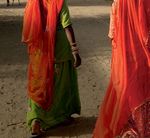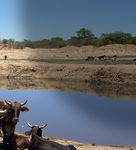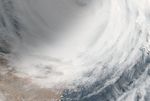SFDRR through a CCA lens - Sendai Framework for Disaster Risk Reduction through a climate change adaptation lens - Placard
←
→
Page content transcription
If your browser does not render page correctly, please read the page content below
Sendai Framework for
Disaster Risk Reduction
through a climate change
“ disasters
” adaptation lens
Three out of four humanitarian
are now climate-related
UN Secretary-General Ban Ki-moon
SFDRR
through a
CCA lens1 Global targets of Sendai Framework For Disaster What does it mean for climate
Risk Reduction (SFDRR), A–G change adaptation (CCA)?
The targets below are a basis for monitoring and evaluation of SFDRR. There
are no clearly defined numerical targets, the achieved change should be
• Consistent with climate change adaptation goals
“substantial”, often with regard to the global outcome.
in the context of climate risk assessment and
Targets A–D: aim to protect of life and assets including critical achievement of climate resilience.
infrastructure
A Substantially reduce global disaster mortality by 2030, aiming to lower
average per 100,000 global mortality rate in the decade 2020–2030
compared to the period 2005–2015.
• Joint pressure from climate change adaptation (CCA)
B Substantially reduce the number of affected people globally by 2030,
& disaster risk reduction (DRR) communities can help
aiming to lower average global figure per 100,000 in the decade 2020–2030
to increase the overall number of countries with
compared to the period 2005–2015.
climate-risk strategies.
C Reduce direct disaster economic loss in relation to global gross domestic
product (GDP) by 2030. • Under the Paris Agreement (PA) countries should
D Substantially reduce disaster damage to critical infrastructure and disruption deliver National Adaptation Plans (NAPs) – new
of basic services, among them health and educational facilities, including or updated versions – by 2020. Under SFDRR,
through developing their resilience by 2030. national and local strategies for DRR should also
be developed by 2020. Duplication of effort can be
Target E: aims for institutional strengthening and further development
avoided if climate-risk related tasks are appropriately
of DRR policies across different levels
aligned.
E Substantially increase the number of countries with national and local
• CCA narrative focuses on global impacts. DRR’s long
disaster risk reduction strategies by 2020.
experience with work on the ground (“community-
The engagement at a local level – authorities, but also businesses and people based DRR”) can be used by the CCA community to
– is particularly important in the DRR context as disasters and extremes occur mainstream its actions into overall prevention and
most often on the local level. Preparing and adapting to climate-exacerbated preparedness.
risks is a part of this task.
Target F: aims to improve coordination with other fields and political • Climate community working with the International
frameworks with a particular emphasis on developing world Mechanism for Loss and Damage (L&D) could
benefit from DRR community experience in that
F Substantially enhance international cooperation to developing countries
area. In particular, DRR could provide a good
through adequate and sustainable support to complement their national
orientation for target values, effective monitoring
actions for implementation of this Framework by 2030.
and measurement. However, it is crucial that
SFDRR created an informal link to the International Mechanism for Loss and both communities agree on a standardised and
Damage (L&D) established in November 2013 at the UNCCC’s Conference unambiguous definition of L&D.
of Parties (CoP) in Warsaw. A formal reference – “common but differentiated
• DRR knowledge in development aid can be used to
responsibilities” – that would acknowledge liability of developed countries to
evaluate if climate finance is sustainable and truly
support poor countries in fighting climate-amplified risks was rejected in the
effective by assessing its ability to improve general
final document after a heated debate (Mysiak et al. 2016).
living conditions.
DRR community has a lot of experience in development work and aid. It also
• DRR experience in population evacuation can be
has a very broad risk perspective, including socioeconomic and political factors.
used by the CCA community to deal with climate
Target G: aims to enhance of prevention and preparedness migration movement.
G Substantially increase the availability of and access to multi-hazard early • The development of early-warning systems and risk
warning systems and disaster risk information and assessments to the information and assessments undoubtedly advances
people by 2030. preparedness for extreme events (which is also an
integral part of adaptation) and offers a unique
SFDRR pledges a multi-hazard, science-informed risk policymaking process.
opportunity to harmonise CCA and DRR, e.g. with
Paragraph 25b “…global and regional levels” should “promote the regard to indicators. This can lead to more effective
conduct of comprehensive surveys on multi-hazard disaster risks and the working by avoiding duplication and creating
development of regional disaster risk assessments and maps, including synergies by bringing together different knowledge
climate change scenarios” (UNISDR 2015b, p. 10). pools.To realise that goal, non-sensitive, local-level data with reference to past events • Risk modelling and simulation, predominantly
(spatial and temporal information), their financial impact – including spillovers on the local level, are an important part of the
– must become broadly available to conduct reliable risk assessments. risk assessment and enhancement of prevention
and preparedness. With regard to climate-related
risk, the CCA community with a strong scientific
2 SFDRR priorities for action, 1-4 background can help to complete that task. The
importance of the “climate” factor was emphasised in
Priority 1: Understanding disaster risk
Paragraph 34c of SFDRR that mentions connections
SFDRR presents disaster risk management in a broader context, going beyond to the Global Framework for Climate Services.
natural disasters and catastrophes and taking into account institutional
• A very broad risk perspective can be useful in
and socioeconomic factors such as poverty, excessive extraction of natural
adaptation work, especially where different types
resources, biodiversity loss. Climate change is noted as a hazard driver, although
of risk are at work. For example, heavy roofs tightly
it can also diminish some disaster risks (Kelman 2015). Adaptation to climate
bonded to walls in general help to protect people
change belongs naturally with DRR prevention and preparedness work.
and assets in the case of tropical cyclones as an
The definition of risk offered by DRR community combines hazards and adaptive measure, but can increase injuries to
vulnerability. The latter plays a very important role in the DRR context. Climate people during earthquakes (Menoni 2011).
change can affect vulnerability due to rapid changes in local circumstances that
• Negative consequences of CC related to local food
communities cannot handle (Kelman 2015). But climate change can also affect
and water resources and climate-related changes in
long-term vulnerability as, for example, populations move from increasingly
ecosystems are well known to the CCA community.
uninhabitable areas into cities which are increasingly suffering from the Urban
However, the notion of the vulnerability underlies
Heat Island (UHI) and its indirect effects.
increased risk and conflicts related to these
Priority 2: Strengthening disaster risk governance to manage developments.
disaster risk
• Coordinating SFDRR with the PA can significantly
SFDRR calls for coordination with other political agreements and improve prevention and preparedness for climate
mainstreaming DRR into other fields: risks, facilitating the achievement of related
SFDRR and PA goals and reducing the overall
Paragraph 47d “… incorporate disaster risk reduction measures into
reporting burden. It also increases the chance to
multilateral and bilateral development assistance programmes within and
realise multiple (adaptation) co-benefits, such as
across all sectors, as appropriate, related to poverty reduction, sustainable
better quality of life, including lower exposure to
development, natural resource management, environment, urban
natural hazards, improved infrastructure, improved
development an adaptation to climate change” (UNISDR 2015b, p. 22).
health and education system, and more effective
Paragraph 28b “… foster collaboration across global and regional
governance (Sethi and Puppim de Oliveira, 2018)
mechanisms and institutions for the implementation and coherence of
instruments and tools relevant to disaster risk reduction, such as for climate • Progress of SFDRR is assessed globally, but countries
change, biodiversity, sustainable development, poverty eradication, report nationally. As a result, overall global indicators
environment, agriculture, health, food and nutrition and others, as can be completed by using national indicators to
appropriate” (UNISDR 2015b, p. 13). make the monitoring and reporting scale between
SFDRR and PA consistent (national level).
Priority 3: Investing in disaster risk reduction for resilience
• A lion’s share (70-85%) of total investments is
DRR puts emphasis on public and private investment in disaster risk prevention
accomplished by private business (UNISDR 2015).
and reduction. It pledges for a multi-stakeholder approach involving private
If done appropriately, these can help to decrease
sector, local governments and communities. Successful partnerships include
overall risk as well as climate-amplified risks. Close
the Making Cities Safe campaign or the Worldwide Safe Schools Initiative
cooperation with the DRR community can bring
(UNISDR 2015)
practical adaptation to climate change forward
Priority 4: Enhancing disaster preparedness for effective response and substantially.
to “Build Back Better” in recovery, rehabilitation and reconstruction
• The DRR community promotes a “build back
SFDRR recognises the urgent need for prevention and preparedness and well better” approach, taking into account an integrated
as thoughtful reconstruction after major events taking into account future risks. and future-oriented risk assessment. This can be
This task requires an enhanced multi-risk forecasting approach. translated as “build forwards based on lessons
learned” in the context of climate change. SFDRR
Paragraph 33a “…Prepare or review and periodically update disaster
clearly recognises the importance of climate
preparedness and contingency policies, plans and programmes with
change as a hazard driver and opens the door for
the involvement of the relevant institutions, considering climate change
cooperation.
scenarios and their impact on disaster risk” (UNISDR 2015b, p. 16).3 Conclusion
Coordination with SFDRR can lead to more effective
policies through joining of forces, more efficient
use of resources, and improved prevention and
preparedness with regard to climate-related risks.
References:
SFDRR overview UNISDR (2015): Coherence and mutual reinforcement
between the Sendai Framework for Disaster Risk Reduction
Goal 2015-2030 and international agreements for development
and climate action. www.unisdr.org/we/inform/
• “The substantial reduction of disaster risk and losses in lives, publications/45001
livelihoods and health and in the economic, physical, social, cultural
and environmental assets of persons, businesses, communities and UNISDR (2015a): Chart of the Sendai Framework for Disaster
Risk Reduction 2015-2030. www.unisdr.org/we/inform/
countries.”
publications/44983
Time horizon
UNISDR (2015b): Sendai Framework for Disaster Risk
• 2015–2030 (15 years) Reduction 2015–2030. www.un.org/en/development/
desa/population/migration/generalassembly/docs/
Agreement type globalcompact/A_RES_69_283.pdf
• Voluntary Kelman, I. (2015) Climate change and the Sendai Framework
for Disaster Risk Reduction. International Journal of Disaster
Stakeholders
Risk Science. 6: 117–127.
• Multi-stakeholder approach incl. local government and business
Kelman, I., Glantz, M.H. (2015) Analyzing the Sendai
Monitoring, assessment and reporting Framework for Disaster Risk Reduction. International Journal
of Disaster Risk Science. 6: 105–106.
• 2015–2020: “set-up phase” for establishment of national and local
DRR strategies Menoni, S. (2001) Chains of damages and failures in a
metropolitan environment: some observations on the Kobe
• 2020–2030: real assessment period in comparison to 2015 baseline earthquake in 1995. Journal of Hazardous Materials, 86:
101–119.
• The progress of SFDRR will be measured every two years by the
UNISDR and presented in the Sendai Framework Progress Report. Mysiak, J., Surminski, S., Thieken, A., Mechler, R. Aerts, J. C. J.
Seven global targets (A-G) of the Sendai Framework will be assessed H. (2016) Brief communication: Sendai framework for disaster
by means of 38 numerical indicators. First progress report is risk eduction – success or warning sign for Paris? Natural
Hazards and Earth System Sciences, 16(10): 2189–2193.
expected to appear in 2019 – countries start reporting from March
2018 via online monitoring system – and will report on the trends Sethi, M., Puppim de Oliveira, J.A. [Eds] (2018) Climate,
in the implementation process during two periods, 2015–2016 and Mitigation, Adaptation or Co-benefits? In Mainstreaming
2017–2018. Climate Co-Benefits in Indian cities. Post Habitat III
Innovations and Reforms. Springer, pp. 12–13
www.placard-network.eu
PLACARD interchange – PLAtform for Climate Adaptation and Risk reDuction @PLACARD_EU
– is a hub for dialogue, knowledge exchange and collaboration between
the climate change adaptation (CCA) and disaster risk reduction (DRR)
communities.
Funded by the European Union’s Horizon 2020 Research & Innovation
Framework programme. Grant agreement No. 653255You can also read



























































